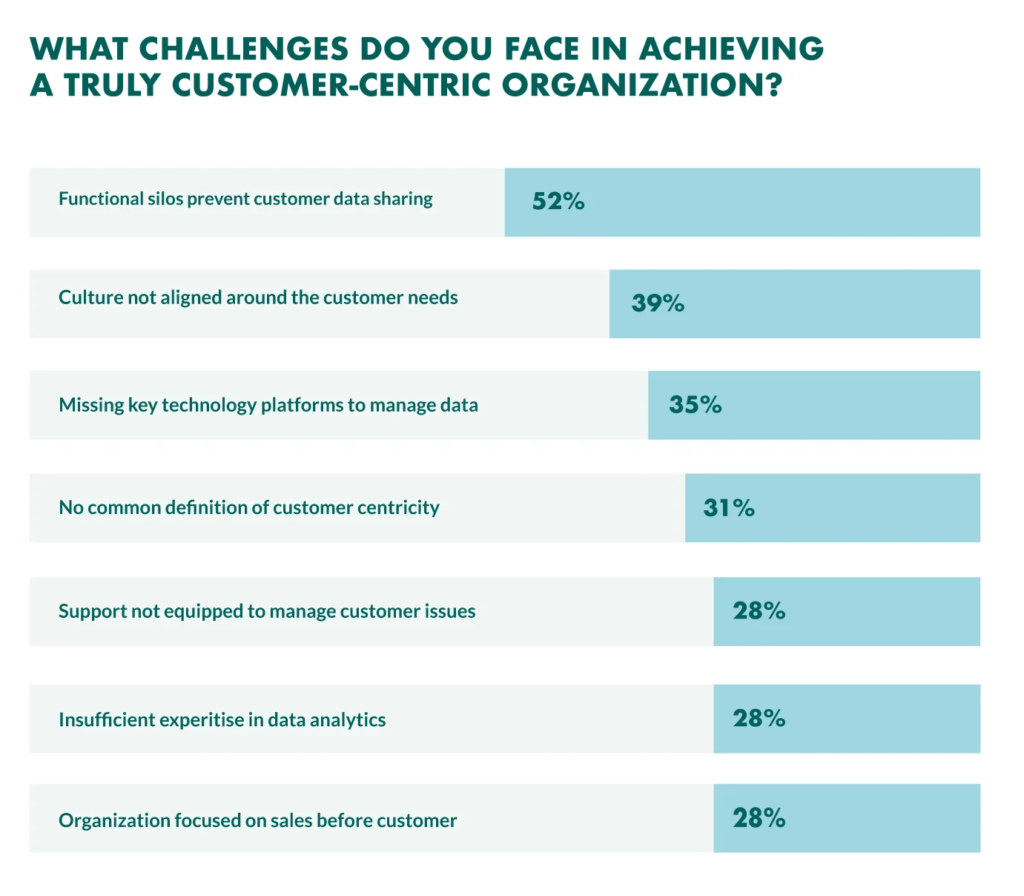Interdepartmental conflicts are typical in the workplace for varying reasons. But some departments take it a step further to almost rivalry. You probably know of the sales vs. marketing teams. But this article focuses on the other great pair of rivals: sales vs. customer service teams.
The sales and customer service teams’ rivalry stems from their roles’ connected but disconnected nature. The two groups work the most with customers. Sales teams get the client, and the customer service teams provide support, ensuring customer satisfaction and retention.
When the two teams are not collaborating as they should, they create departmental and data silos that hurt the customer and the organization.
For instance, sales teams convert customers without customer care input, leading to the conversion of unqualified customers. These customers end up disappointed, and the customer service teams must resolve this.
To avoid this, these two departments should work in synergy throughout the customer development process to ensure customer retention, which is every business’s goal. If a collaborating sales and customer care team is what you want for your organization, read on for four foolproof ways to achieve it:
1. Organize Cross-Team Training Sessions
Cross-training sessions educate employees on how to perform the duties of other employees in other departments. So, by organizing the training sessions, your sales and customer service representatives gain skills that help them work more collaboratively. It also reduces the dependency on a single team to perform specific duties.
For instance, when your customer service agents have the same knowledge and soft skills as the sales team, they can answer customer questions directly on live chat or email without the sales rep. They could even use customer questions to determine if the customers are quality leads they can pass on to the sales team.
Adopting a cross-training culture will also help expose the two teams to the challenges each team faces. As a result, the two teams gain more understanding of each other’s roles and realize how their decisions affect each other’s work. This also opens internal communication lines allowing the two to discuss how they can collaborate to perform their roles better.
The best thing about cross-training is that you don’t have to break the bank to do it for your teams, especially when starting a business. You can create a tremendous in-house cross-training program by following the process visualized below and customizing it to work for your teams.
You’ll need a strong team leader or sales and customer service managers. But if you notice your program is not performing well after a while, you can outsource sales and customer support specialists.
2. Identify Opportunities to Cross-Sell and Up-Sell
The other way your sales and customer service teams can work together is to identify cross-selling and upselling opportunities. The cross-selling technique encourages customers to purchase complementary products to the one they are using, like the case of phones and phone cases.
This iHerb image is an excellent example of cross-selling. Though the customer is looking for organic wheat grass powder, iHerb suggests spirulina and root powder as complementary products.

The upselling encourages customers to upgrade their current products. The product recommendations could encourage leveling up from a basic plan to a premium one, as shown in the Spotify example.
These marketing strategies are great for all online businesses. Yes, including SaaS companies, so feel free to include them in your SaaS marketing plan. But there is a catch. They only work well when done right and at the ideal time. So you have to ensure your recommendations look more helpful than promotional.
Your customer service reps can help sales reps quickly identify these opportunities. It is easier for them since they speak to customers more often than the sales team. Customer service teams can easily identify the key moments in a customer’s journey or lifecycle that show they are ready to spend more and will respond positively.
By working collaboratively and suggesting these upselling and cross-selling opportunities for customers, the teams increase the customer’s lifetime in your organization. Such positive results are a win for the teams, which boosts the teams’ productivity and motivates more collaboration.
3. Exchange Customer Interaction Data
Departmental silos limits teams to the data they collect and the specific siloed tools. This is very dangerous for the sales and customer service teams since they work with the same customers. Not sharing customer interaction data means a team is on different pages, which leads to poorly informed decisions and customer misinformation.
The sales team should be able to see ongoing interaction with the customer service team to identify qualified leads and potential repeat customers. But since most customer interaction data is kept in the customer service tools and systems, they might convert unqualified leads who end up frustrated customers.
This data transparency also makes resolving customer inquiries and conflicts easy. It is also quick since either team can access customer history without asking customers to repeat details. Hubspot research showed that 33 percent of customers are most frustrated by having to repeat themselves to multiple support reps.
The other way to break the siloed data walls is by implementing Customer Relationship Management (CRM) systems. CRMs track and safely store customer data and experiences from different platforms since most have omnichannel support. Most also have the bonus of data analytics, making it easy for any team to use the data.
An excellent example of such a system is the Zendesk Sell, which documents any customer interactions, as shown below.
You also need to encourage departmental communication to allow for data exchanges on customer interactions. To ensure efficiency, you can use communication tools like Slack. The communication platform enables cross-team reporting to provide clear goals and direction trajectories. This builds more trust amongst the teams.
By encouraging the exchange of customer interaction data and open communication channels, you also allow more efficient collaborations among the teams. Each team member learns the specific customer service staff to work with to provide excellent customer service.
For instance, say customer service rep A knows that sales rep B is in charge of higher-budget accounts. If customer service rep A has a higher-budget customer complaint, the customer support rep can consult them directly and efficiently solve the customer issue.
4. Create a Customer-Centric Approach
A customer-centric approach lets you put your customer first and connect your business to the customer’s specific needs. As a result, you provide positive customer experiences that earn you loyal clients. The approach also brings sales and customer service teams together since it prioritizes their main shared goal, customer satisfaction.
Your customer-centric approach should encourage the teams to collaborate to ensure customer expectations match the customer journey. This means giving each customer quality since they get what each team promises them.
This requires the teams to be on the same page, encouraging them to work collaboratively to ensure consistent and excellent service. This is what most people look for. A recent Forbes showed that 58 percent of customers will pay extra to receive great customer service.
For instance, promote a culture where both the sales and customer service teams can interact and respond to incoming customer requests and inquiries, provided they understand the context and customer history. This helps avoid delayed responses or assistance to customers. It also helps reduce data silos which are a big threat to creating a customer-centric organization, as shown below:

You also need to encourage both teams to build connections with customers. The relationship between the teams and customers does not need to be transactional. They can create other touchpoints that help your company gain loyal clients who send customer referrals your way.
For example, it could constantly be asking how the product serves them. Also, show them that you take their customer feedback seriously by making amends.
This will require the two teams to work together since it is not only the customer care representatives that need to relate with the team after sales. The sales reps also need to maintain the gained customer relations.
Wrapping Up
Teamwork makes the dream work. This is often the case when organizations encourage their sales and customer teams to work in synergy. So if excellent customer service that leads to satisfaction and retention is the main focus for your company, it is time for the two teams to collaborate to achieve this.
This article discusses four ways. The first is to organize cross-team training sessions. Then, discourage siloed departmental data by encouraging customer interaction data exchange.
You should create a customer-centric approach to ensure both departments have aligned departmental goals. Also, identifying cross-selling and upselling opportunities is something they can do together to increase the chances of higher conversion rates.
When you ensure that your sales and customer service team are on the same page, you can create better customer experiences. The result? Happier customers and increased customer retention.
Follow these tips today!
About the Author: Austin Andrukaitis is the CEO of ChamberofCommerce.com. He’s an experienced digital marketing strategist with many years of experience creating successful online campaigns. Austin’s approach to developing, optimizing, and delivering web-based technologies has helped businesses achieve higher profit, enhance productivity, and position organizations for accelerated sustained growth.













